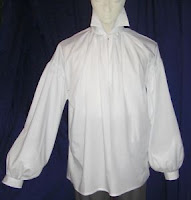For Regency gentlemen, clothes were also a complex
matter with various items to be worn as well as outfits for different events. This
new style (unlike the over the top colourful fashions of the period before) was modeled on the riding outfit and was meant to be natural and simple (Pool, 1993). There are also
special uniforms for those gentlemen in the army or the navy. The standard suit
is comprised of 5 elements: the shirt, pants, waistcoat, cravat and coat. Like
the women, men had different outfits for different events. There is morning
dress and evening dress.
Shirt
A simple white linen shirt worn under any outfit. It
is loose fitting with long puffy sleeves and a collar that is stood up to touch
the chin on both sides.
 |
| Gentleman's white linen shirt: Note how high the collar is |
Waistcoat
A waistcoat during the day tended to be more colourful
and decorative. A waistcoat worn during the evening or at a ball tended to be
more sober in colour (black, grey and white as an example) and was made of
silk, for the wealthy. (Foley, 2012). Waistcoats were sleeveless and some also had
pockets. For a man to be
seen without his waistcoat by a lady is considered extremely improper.
 |
| Different types of waistcoats |
Cravat
This was a piece of linen tied around the upturned
collar of the shirt made of started muslin and white in colour (Sullivan, 2007). Similar to the
modern bow tie except there are several variations.
 |
| Actual 19th century guide to neckcloths |
Pants
During the day, pantaloons or breeches were worn.
Pantaloons are the predecessor of the modern day suit pant and breeches were
tight fitting and were fastened at the grain area with a rectangular piece of
cloth called ‘falls’ (Foley, 2012). Gradually through
the Regency, breeches decreased in popularity, to be replaced by pantaloons.
During the evening, men would wear keen-length breeches
with stockings as this picture shows.
 |
| Note knee length breeches and white stockings |
Coat
Outer garment which came in two variations: a frock
coat worn during the day and a dress coat which was worn at night (Pool, 1993). The difference was
the frock coat tended to be more colourful where the dress coat was black in
colour. The coat tended to have high lapels and was double tailed. A greatcoat
was larger and would have up to sixteen capes and would be worn outdoors when
riding to protect the gentleman from rain or the cold (Sullivan, 2007).
 |
| Morning/riding clothes: boots are worn during the day |
Accessories
- Shoes: During the day, boots reaching to the knee were worn and at a ball shoes with buckles would be worn with gentlemen’s stockings and breeches.
- Hats: The typical top hat was worn outdoors and only during the day.
- Gloves: Black for day wear and white for evening wear.
- Jewellery: Rings, brooches (pinned to a gentleman’s cravat) and fob watches (put inside a man’s waistcoat or breeches pocket) were popular pieces (Byrde, 2008).
- Walking Stick: A must for any proper gentleman. Normally had a head of ivory or silver.
 |
| Walking Stick |
Military
outfits
Because England was fighting a war during this time, those men in the military would wear their costumes during formal events but NOT during the day. This is an honorable distinction for those who are serving their country.
 |
| The Duke of Wellington in his army outfit |
Sources:
Byrde, P. (2008). Jane Austen
Fashion. Ludlow: Moonrise Press.
Foley, G. (2012). History Article 2: THE GENTLEMAN'S WARDROBE. Retrieved
April 28, 2012, from Gaelen Foley NYT Bestselling Author of Historical Romance:
http://www.gaelenfoley.com/h-02-gentswardrobe.html
Pool, D. (1993). What Jane Austen Knew and Charles Dickens Ate. New
York: Touchstone.
Sullivan, M. C. (2007). The Jane Austen Handbook. Philadelphia:
Quirk Books.
No comments:
Post a Comment